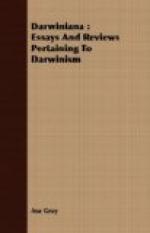5. The overlapping of existing and extinct species, and the seemingly gradual transition of the life of the drift period into that of the present, may be turned to the same account. Mammoths, mastodons, and Irish elks, now extinct, must have lived down to human, if not almost to historic times. Perhaps the last dodo did not long outlive his huge New Zealand kindred. The aurochs, once the companion of mammoths, still survives, but owes his present and precarious existence to man’s care. Now, nothing that we know of forbids the hypothesis that some new species have been independently and supernaturally created within the period which other species have survived. Some may even believe that man was created in the days of the mammoth, became extinct, and was recreated at a later date. But why not say the same of the aurochs, contemporary both of the old man and of the new? Still it is more natural, if not inevitable, to infer that, if the aurochs of that olden time were the ancestors of the aurochs of the Lithuanian forests, so likewise were the men of that age the ancestors of the present human races. Then, whoever concludes that these primitive makers of rude flint axes and knives were the ancestors of the better workmen of the succeeding stone age, and these again of the succeeding artificers in brass and iron, will also be likely to suppose that the Equus and Bos of that time, different though they be, were the remote progenitors of our own horses and cattle. In all candor we must at least concede that such considerations suggest a genetic descent from the drift period down to the present, and allow time enough—if time is of any account— for variation and natural selection to work out some appreciable results in the way of divergence into races, or even into so-called species. Whatever might have been thought, when geological time was supposed to be separated from the present era by a clear line, it is now certain that a gradual replacement of old forms by new ones is strongly suggestive of some mode of origination which may still be operative. When species, like individuals, were found to die out one by one, and apparently to come in one by one, a theory for what Owen sonorously calls “the continuous operation of the ordained becoming of living things” could not be far off.
That all such theories should take the form of a derivation of the new from the old seems to be inevitable, perhaps from our inability to conceive of any other line of secondary causes in this connection. Owen himself is apparently in travail with some transmutation theory of his own conceiving, which may yet see the light, although Darwin’s came first to the birth. Different as the two theories will probably be, they cannot fail to exhibit that fundamental resemblance in this respect which betokens a community of origin, a common foundation on the general facts and the obvious suggestions of modern science. Indeed—to turn the point of a pungent simile directed against Darwin—the difference between the Darwinian and the Owenian hypotheses may, after all, be only that between homoeopathic and heroic doses of the same drug.




